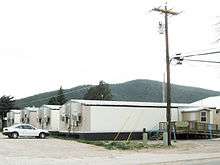Mora, New Mexico
| Mora, New Mexico | |
|---|---|
| census-designated place | |
 Mora Location within the state of New Mexico | |
| Coordinates: 35°58′27″N 105°19′48″W / 35.97417°N 105.33000°WCoordinates: 35°58′27″N 105°19′48″W / 35.97417°N 105.33000°W[1] | |
| Country | United States |
| State | New Mexico |
| County | Mora County |
| Elevation[1] | 7,172 ft (2,186 m) |
| Time zone | MST (UTC-7) |
| • Summer (DST) | MDT (UTC-6) |
| Area code | 575 |
| FIPS code | 35-50090 [1] |
| GNIS feature ID | 0915867 [1] |
Mora or Santa Gertrudis de lo de Mora is a census-designated place in, and the county seat of, Mora County, New Mexico, United States. It is located about halfway between Las Vegas, New Mexico and Taos on Highway 518 at an altitude of 7,180 feet. The Battle of Mora and the Second Battle of Mora were fought in Mora in 1847, where US troops eventually defeated the insurgents, effectively ending the Taos Revolt in the Mora Valley.
History


Hispanic settlers had occupied lands within the Mora Valley without legal title ever since Governor de Anza had made peace with the Comanches in the late 18th century opening up the east side of the Sangre de Cristo Mountains for settlement. However, Mora was formally founded as a farming community in 1835[2] The settlers came primarily from Las Trampas, but also from Picuris and Embudo.[3] The 76 families each received a strip of land by grant of Governor Albino Perez.[2] Despite fanciful stories about fur trappers, scattered bones and subsistence on mulberries (mora means mulberry in Spanish), the fact is that the valley, the river and the town took their name from the family name "Mora" of several of the settler families.[2] In 1843, there was a raid on the town by Texas freebooters under Colonel Charles A. Warfield[4] claiming that the people in Mora had purchased stolen beef from the Comanches. The Texans killed five men and took eighteen women and children captive as well as 75 horses. The people of the Mora Valley convened a posse, overtook the Texans, and sent them back to Texas on foot.[3]
In 1847, after the Battle of Mora, Federal troops killed stragglers, looted and burned the town, the nearby ranches, and all the crops.[5] The town was essentially destroyed and was rebuilt by the insurgents who had fled at the news of artillery coming up the valley. After 1851 when Fort Union was established on the Santa Fe Trail, these same farmers sold their crops to the fort.
Ceran St. Vrain settled in Mora in 1853 built a grist mill and became a major supplier of flour, grain and fodder to Fort Union. At the peak in the 19th century there were five grist mills operating in Mora. The ruins of St. Vrain’s mill still sit one block north of Mora’s main street.[3]
On 22 February 1916, the common lands of the Mora landgrant are sold to "The State Investment Company" at the courthouse door in Mora.[6] Without access to the grazing and timbering lands, many residents sought work outside Mora.[6]
Cultural references
The settlement is mentioned in Willa Cather's 1927 novel Death Comes for the Archbishop, Book Two Chapter 2.
One of Frank Waters’s most popular novels, "People of the Valley" takes place high in the Sangre de Cristo mountains where an isolated Spanish-speaking people confront a threatening world of change. Based on Mora, NM ISBN 0-8040-0243-6
Mora was also in "The Daybreakers" by Louis L'Amour. The character Orrin Sackett was the fictional Marshal of Mora.
Notable people
- Floyd Esquibel, member of the Wyoming Senate and former member of the Wyoming House of Representatives[7]
References
- 1 2 3 4 Geographic Names Information System (GNIS) details for Mora, New Mexico; United States Geological Survey (USGS); November 13, 1980.
- 1 2 3 Pearce, T. M. (1965) "Mora" New Mexico place names; a geographical dictionary University of New Mexico Press, Albuquerque, NM, p. 104, OCLC 420847
- 1 2 3 Noble, David Grant (1994) "Mora" Pueblos, Villages, Forts & Trails: A Guide to New Mexico’s Past University of New Mexico Press, Albuquerque, pp. 175-179, ISBN 0-8263-1514-3
- ↑ Bullock, Alice (1981) "Lo de Mora" Mountain Villages (2nd ed.) Sunstone Press, Santa Fe, NM, p.53-58, ISBN 0-913270-13-X
- ↑ Goodrich, James W. (1972) "Revolt at Mora, 1847" New Mexico Historical Review 47(1): pp. 49-60, p. 56
- 1 2 Sálaz, Rubén Darío (1999) New Mexico: A brief multi-history Cosmic House, Albuquerque, p. 430, ISBN 0-932492-05-3
- ↑ "Senator Floyd A. Esquibel". State of Wyoming Legislature. Retrieved November 6, 2012.
Further reading
- Stanley, Francis (1963) The Mora, New Mexico Story Pep, Texas OCLC 2744942
External links
| Wikimedia Commons has media related to Mora, New Mexico. |
- Official Mora County Website
 Mora travel guide from Wikivoyage
Mora travel guide from Wikivoyage
